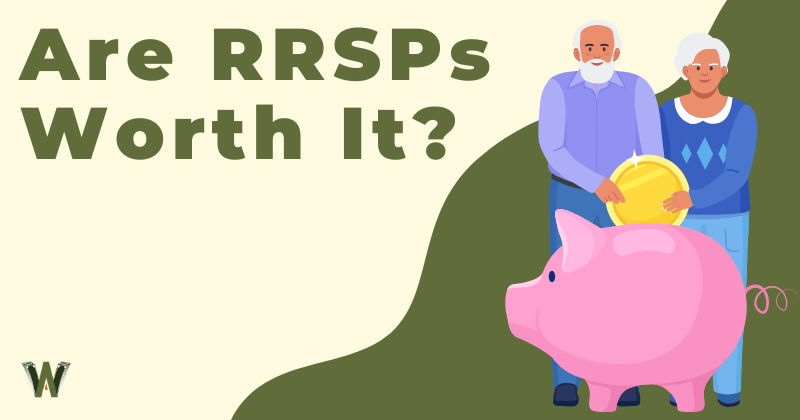Are you considering opening a Registered Retirement Savings Plan (RRSP), but are unsure whether or not RRSPs are worth the hassle?
An RRSP account can be extremely valuable, especially if you are currently in a high tax bracket and are likely to be in a lower one in the future.
The RRSP account allows you to defer paying taxes on your income to a future date. Investments within an RRSP are free from tax implications until the money is withdrawn from the account.
Although the RRSP is a great account type that is a staple in most financial plans for Canadians, the decision around whether to contribute to an RRSP (instead of a Tax-Free Savings Account, for example) will depend on your specific circumstances.
So are RRSPs worth it? Find out the pros and cons below.
How do RRSPs Work?
The RRSP has been in effect in Canada as an account type since 1957. As a registered account, you can choose to have one RRSP or many RRSPs at different financial institutions as long as specific criteria are met.
Contributions to an RRSP are limited to 18% of your earned income in the past year or a specified maximum amount each year ($30,780 for 2023). Keep in mind that this limit applies to all of your RRSP accounts combined.
Income that is contributed to an RRSP within a specific year is not counted toward that year’s income for tax purposes. For example, if you earned $100,000 in a specific year and decided to contribute $10,000 to an RRSP, you would only be paying income taxes on the remaining $90,000.
You can withdraw money from an RRSP at any time, although withdrawals will face a withholding tax at source. The amount of withholding tax on a withdrawal will depend on how much you are taking out of the account:
- 10% (5% in Quebec) for withdrawals up to $5,000
- 20% (10% in Quebec) for withdrawals between $5,000 and up to $15,000
- 30% (15% in Quebec) for withdrawals over $15,000
At the end of the year, the CRA will consider how much you have paid in withholding tax relative to your overall tax liability and adjust the amount that you owe or are owed accordingly.
An RRSP can hold a wide range of asset classes, including cash, funds, bonds, stocks, GICs, and more. Trading within a Registered Retirement Savings Plan does not have any tax implications as long as money is not withdrawn from the account.
Withdrawing Money From an RRSP
When money is withdrawn from an RRSP (including any growth while in the account), it is treated as income in that particular year. You can use this to your advantage to withdraw from your RRSP in years when you are expecting to have a lower relative income.
An RRSP must be turned into a Registered Retirement Income Fund (RRIF) before the end of the year in which you reach 71 years of age. An RRIF account comes with a minimum amount that must be withdrawn each year from the account based on your age.
RRSP Account Benefits
An RRSP offers certain benefits relative to a regular investment account (or a non-registered account).
1. Growing your Money before Taxes are Paid
Since you would normally be responsible for paying taxes in any given year on income, you would typically have a smaller amount to invest when considering your tax liability.
By deferring the tax liability until after your investments have compounded, you are actually able to grow your investments by substantially more.
The effects of compounding are especially larger over longer periods of time. Instead of paying income taxes on the amount of money that you are contributing to your RRSP, you are able to grow the tax amount by whatever rate of return you are earning within the account.
2. Trading within an RRSP without Tax Implications
In a non-registered account, taxable events can cause taxes to be owed to the government on a consistent basis. Anytime that you are receiving income from a bond or selling a stock at a gain, you are required to pay some form of taxes (in non-registered accounts).
Transactions within an RRSP account are tax-exempt, meaning that they do not incur tax implications. This means that you can rebalance an RRSP portfolio as often as you want.
You also don’t have to consider the type of investment return that you are getting (how tax-efficient it is) since the whole account will eventually be taxed as income down the road.
3. Withdrawing Money in Years of Low Income
Contributing to an RRSP is especially valuable if you are expecting to have lower taxable income at some point in the future.
If you are currently in a high-income tax bracket, you may be able to defer paying taxes on your RRSP contributions to a year in which you are in a lower-income tax bracket. This means paying a lower tax percentage.
Downsides of the RRSP
1. Confusing to Many Canadians
Many people don’t understand exactly how the RRSP works, so they don’t bother using it. It’s much harder to understand the tax deferral and conversion to an RRIF than another simpler account, such as the TFSA.
2. Less Flexibility Than the TFSA
If you decide to withdraw money from your RRSP, that contribution room will be lost forever. This is why it is ill-advised to withdraw the RRSP earlier than retirement in most cases. Contrast this to the TFSA, which is much more flexible, and you can re-contribute whatever you withdraw in the next year.
3. Contribution Room Depends on Your Income
The RRSP room you are allowed depends on your income, which many Canadians find unfair for lower-income earners. Contrast this to the TFSA, where every Canadian receives the same amount yearly.
Investing: RRSP vs TFSA
The decision around whether to invest through an RRSP or a TFSA can be a difficult one to make – it again depends on your personal circumstances.
A Tax-Free Savings Account allows you to invest after-tax dollars without any Canadian tax implications.
Knowing what tax brackets you are in will help you to figure out how much to contribute to your RRSP. So which one should you choose? Here are a few things to keep in mind:
- If you are in a lower tax bracket, it almost certainly makes sense to max out your TFSA first before considering contributing to your RRSP. Because you are in a lower tax bracket, you won’t be benefiting as much from your RRSP tax refund. When you are making more money and in a higher tax bracket, that RRSP contribution room isn’t going anywhere and you can still use it.
- A big exception to this is if your employer offers a matching Group RRSP program. In this case, always contribute the maximum amount, and choose the Group RRSP before the TFSA or regular RRSP. See the next section for why:
- I personally like to max out my TFSA every year, then I consider what tax bracket I am in for the amount I will contribute to my RRSP. I like the TFSA first because it is easier to predict than the RRSP. With the RRSP, there are a few uncertainties, such as you don’t know what will your tax rate be in the future, plus the government can raise taxes before the time you retire.
For more specifics on when to use one type of account over the other, make sure to read my TFSA vs RRSP guide.
RRSP Tips

There are a few things to keep in mind and take advantage of if you are investing through an RRSP.
Since all investments within an RRSP are taxed the same (once money is withdrawn from the account), it makes sense to keep investments that are taxed the least favourably in the account. Mainly, this includes fixed-income investments such as bonds and bond funds.
Investments that receive favourable tax treatment, such as non-dividend-paying stocks, can be kept in a regular non-registered account.
Your RRSP can also allow you to take advantage of the Home Buyers’ Plan (HBP) as well as the Lifelong Learning Plan (LLP).
You can learn more about the Home Buyers’ Plan through my RRSP first-time home buyer guide.
Conclusion

The Registered Retirement Savings Plan is an excellent registered account that the Canadian government offers to Canadians in order to help them prepare for retirement.
Contributions to an RRSP reduce your taxable income for the respective year, and withdrawals out of an RRSP count as income in the year that they are taken out.
The RRSP is especially valuable if you believe your future income levels will decrease from current levels, allowing you to pay a lower tax rate on future RRSP withdrawals.
Make sure to carefully consider your specific financial circumstances when choosing between investing through a Tax-Free Savings Account or a Registered Retirement Savings Plan.
If you are starting to plan for your retirement and are looking for additional pointers and guidelines, make sure to read my ultimate guide on retirement planning in Canada.




